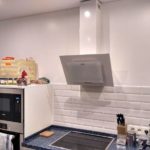The height of the hood above a gas and electric stove or panel
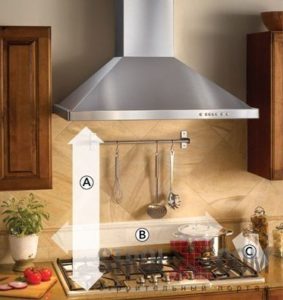 No modern kitchen is complete without an exhaust hood. These devices prevent air pollution in the house with fat particles, combustion products and strong odors that accompany the cooking process.
No modern kitchen is complete without an exhaust hood. These devices prevent air pollution in the house with fat particles, combustion products and strong odors that accompany the cooking process.
When choosing an exhaust hood, many rightfully focus on the aesthetic appeal and technical characteristics of the purchased equipment. At the same time, they miss the issue of the importance of proper placement of the device in the kitchen.
You can choose a technically advanced model that fits perfectly into your interior. But if you make a mistake with the placement of the device, you can end up with a useless and non-functional design. And in some cases it will even be dangerous.
One of the most important aspects of installation is maintaining the required distance between household appliances: hood, gas/electric stove or surface.
Let's figure out at what distance you can hang the exhaust structure.
The content of the article
Types and peculiarities of exhaust devices
Principle of operation
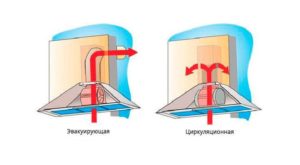
All products currently on the market can be divided into two large classes based on their operating principle: circulation and exhaust.
Circulating
Circulation units provide filtration of kitchen air through a built-in system of multi-stage filters. After this, the purified air is returned to the kitchen.
As a rule, they consist of a separator filter that traps large particles and a carbon filter that absorbs odors.
The polluted air above the stove is drawn into the exhaust hood by a fan, passes through the filter system and ends up back in the room.
The efficiency and productivity of such systems is low. They are recommended to be used only in cases where it is not possible to connect the hood to the ventilation system.
Exhaust
Exhaust structures ensure the removal of polluted air from the premises through the ventilation duct of the building.
In devices of this type, mechanical grease filters must be used to prevent “clogging” of the ventilation duct.
Before choosing a model, it is necessary to calculate the required power of the exhaust hood.
Reference. Maximum performance should provide a twelvefold change of air in the kitchen in 1 hour.
As a rule, many modern models are universal. They can operate in both circulation and exhaust mode, depending on the connection method.
Design
Based on the type of design, hoods are divided into the following types.
- With a flat surface.
- Domed.
- Inclined.
- Built-in.
Flat surface devices
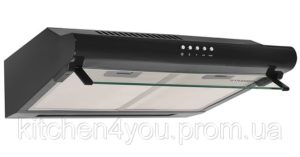
The simplest and most cost-effective type of exhaust devices, characterized by compact size and low price.
These models are able to work most efficiently autonomously in circulation mode, thanks to the filters built inside.
The disadvantages of these devices include the need for regular cleaning and replacement of filter elements. In most cases, technology is not aesthetically attractive enough. These shortcomings are partly compensated by the relatively low cost of the product.
Dome
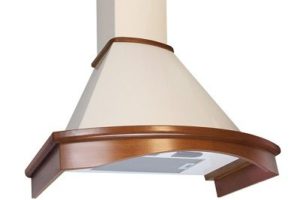
Another type of device that has become widespread in our kitchens.
The main operating mode of devices of this type is exhaust. They capture hot air rising upward, which is saturated with water vapor and fat particles. And then it is removed from the room through the ventilation duct.
The effective operation of these models depends on proper installation. In this case, it is provided even in passive mode, without turning on the built-in fan.
Some models of exhaust hoods provide the possibility of installing carbon filters to ensure operation in circulation mode with reduced efficiency.
Oblique
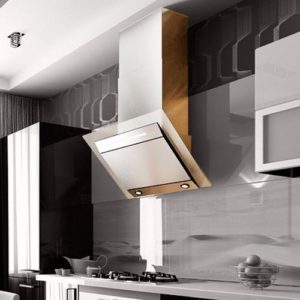
Devices with an inclined surface are a type of dome exhaust devices.
They are considered the most aesthetically perfect and modern. These devices combine an attractive appearance, excellent workplace ergonomics and high efficiency.
The main disadvantage of these devices is the relatively high cost.
Built-in
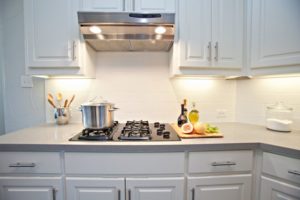
The main difference between these models and those listed above is that the structure itself and the air ducts are hidden from view in the wall cabinet.
How to choose the right place for the hood
The main requirement for the installation location of exhaust devices is to be placed strictly vertically above the surface of the slab.
Important! The size of the product must be equal to or larger than the size of the slab.
When choosing and preparing a site for a ventilation unit, you need to pay attention to the following factors.
- Distance from the ventilation duct.
- Device fan power.
- Possibility of connecting power supply.
If you plan to install an exhaust type device, then it should be possible to install an air duct from the installation site to the ventilation duct of the building.
The air duct path should be chosen as shortest as possible with a minimum number of turns. Failure to comply with this requirement will significantly reduce the efficiency of the device.
If the location of the hob is very far from the ventilation risers, then perhaps you should think about choosing a circulation-type device.
The fan power determines the maximum distance from the surface of the stove at which the device will effectively cope with its functions
An important issue is the availability of electricity near the installation site. The most correct option is to place a separate outlet for the hood above its installation location.
Attention! Given the metal body of range hoods, a ground connection is required to prevent electrical damage.
Distance between cooking equipment and hood
Why know the distance between devices?
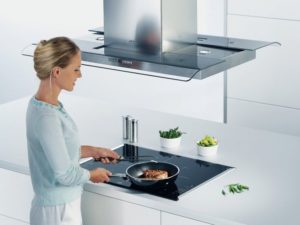
A correctly selected distance between the stove and the hood is the key to a high-quality microclimate and ease of work in the kitchen.
Improper installation may shorten the service life of the device.
Installing a hood is a labor-intensive process.If the unit is installed incorrectly and the device needs to be re-attached, this may lead to damage to the interior of the room.
What is affected by the distance between devices?
The installation height of the hood above the countertop determines several important points:
- safety of equipment operation;
- efficiency of the ventilation system;
- ergonomics of the workspace in the kitchen.
One of the main factors influencing the efficiency of the equipment is the correct distance between the stove and the hood.
If the device is installed too low, the ergonomics of the workspace will be disrupted. You will experience discomfort when cooking. And particles of soot and grease settling on the ventilation grille can ignite.
If the setting is too high, the performance and efficiency of the hood will be reduced. This will require constant use of the exhaust hood at maximum power, reducing its service life. At the same time, the noise level in the house and electricity costs increase.
How to find out regulatory distance requirements
Currently, there is no uniform standard regarding the optimal distance between the surface of the stove and the hood. Each device manufacturer recommends different values depending on the type and performance of the device.
When installing a hood, you should rely on the following criteria:
- room volume;
- type of stove (will be located above electric or gas);
- equipment performance;
- growth of family members.
The rules prescribe strict standards regarding the lower limit of the hood installation.It depends on the type of slab, ensuring fire safety during operation of the equipment.
The upper limit of the installation determines the efficiency of the product and ease of use, therefore it is not regulated by state standards. But it is precisely this parameter that is most important from the point of view of effective use of the device.
Standards
Standard distance for gas stoves and surfaces
If you own a gas stove, then the distance from the hob to the bottom edge of the exhaust hood cannot be less than 75 cm.
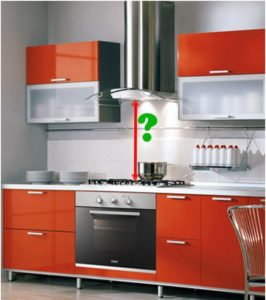
Compliance with this rule will prevent fires. It will also eliminate the possibility of the stove flame going out due to too strong a flow of intake air.
Standard distance for electric stoves and panels
For owners of an electric stove, the standard is much softer, since these products do not contain open fire.
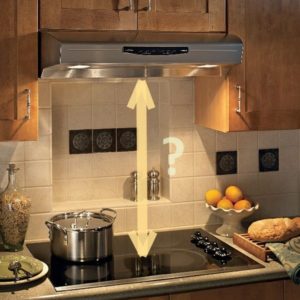
As a result, the risk of fire is lower and the possibility of the flame being extinguished by the sucked air flow is completely absent.
In this case, according to the standard, the minimum distance above the electric stove should be at least 60 cm.
Nuances of device designs and sizes between them
How is the distance determined for combined hobs?
If you own a combination hob, then when choosing a distance you must be guided by the most stringent standard for gas stoves.
That is, leave at least 75 cm between the stove and the lower border of the hood.
How is the distance determined for inclined panels?
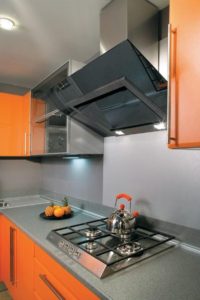
One of the common questions of ordinary people is this: how to correctly measure the distance from the surface of the stove to the inclined model of the exhaust hood.
The answer is simple: you need to measure the minimum distance from the lowest point of the exhaust hood to the surface of the stove.
For the lucky owners of inclined models of exhaust hoods installed above the gas panel, the minimum distance, if necessary, can be reduced to 55-65 cm.
Owners of inclined exhaust hoods that are located above electrical equipment can place the lower edge of the product at a distance of at least 35-45 cm.
We have presented the standards that you need to know to properly place a hood in the kitchen. Now you know at what height you should hang your exhaust hood.
We hope that our tips will be useful and you will cope with the task with ease. And your hood will delight you with clean air in the kitchen.



